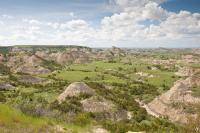
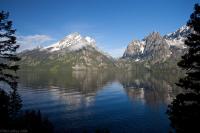
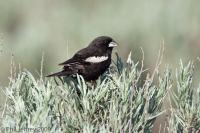
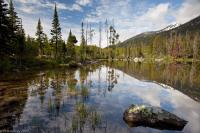
Gallery for aggregated trip photos is at http://www.catharus.com/gallery2/v/MN-ND-WY.
Click on any of the small images in the text below and the corresponding gallery page will open.

phil jeffrey:: MN-ND-MT-WY-SD trip report




Gallery for aggregated trip photos is at http://www.catharus.com/gallery2/v/MN-ND-WY.
Click on any of the small images in the text below and the corresponding gallery page will open.
This is an incomplete version of the trip report for my epic trip across Minnesota, North Dakota, Montana, Wyoming and South Dakota from June 10th-23rd 2009. Although in principle this was a "Prairie Pothole" trip, it became obvious that I could wedge both Yellowstone and the Grand Tetons into a longer loop trip. Since I had been to neither of these places and have a natural affinity for western montane environments I added them at the expense of dragging the trip out to two weeks in length. The other thing is that I had only one prairie life bird of any significance (Baird's Sparrow), one introduced agricultural one (Gray Partridge) and the rest were montane or boreal birds (Ruffed Grouse, Blue Grouse, Black-backed Woodpecker). I had no realistic chance at Yellow Rail on this trip because I do not count heard-only birds. In the schedule Minnesota was given fairly short shrift, and was really on there because flying into Minneapolis was more practical (non-stop from PHL) than other options where I'd pretty much have to change planes in MN anyway. A more linear route of flying into Denver and flying out of Minneapolis may have worked slightly better, however, and reduced the gas-hungry total of 5,500 miles. Those rental car companies have got to love people like me.
Life target list:
The good thing was that the sky had cleared by the time I made the first stop at Rice Lake NWR. The bad thing was that it was already 11am and breezy - nevertheless quite a few birds were singing and I birded there for two hours from 11am-1pm. Sedge Wren, (Golden-winged Warbler), (Clay-colored Sparrow) were the most interesting ones. Many species I just heard and chose not to spend 15 minutes trying to find: (Ovenbird), (Northern Parula), (Least Flycatcher), (Yellow-throated Vireo). Nice extras were Black Tern and Common Nighthawk, the latter the only one for the trip. Savannah and Song Sparrows were common, as were Common Yellowthroat and Alder Flycatcher. The lake itself was quiet with a few Bufflehead, Ring-necked Ducks and Mallard. The passerine species were classical eastern deciduous - in addition to the heard-onlies I actually did see Red-eyed Vireo, Indigo Bunting, Great Crested Flycatcher, Yellow Warbler and Bobolink.
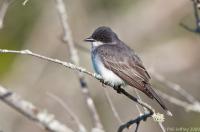 Then I went to nearby Aitkin Twp Road 380 where I saw more Bobolink, Savannah and Song Sparrows but no Ammodramus sparrows, before heading for
Sax-Zim Bog via a winding road that paralleled the west side of the Mississippi River and passed through more grasslands containing
Bobolinks and one or two (Sedge Wrens). The Sax-Zim Bog was a mixed bag, given it was later in the day with a decent breeze. Nashville Warblers
were numerous as were Common Yellowthroats and Alder Flycatchers. I birded Blue Spruce Road east of Meadowlands and
turned up Black-and-white Warbler, White-throated Sparrow, Yellow-bellied Sapsucker. In farm fields off Arkola Rd
while failing to find either Sharp-tailed Grouse or Upland Sandpiper I saw a small flock of Brewer's Blackbirds.
Up McDavitt Rd around sunset while waiting to see if the Great Gray Owl would put in an appearance I saw a fairly tame Broad-winged Hawk.
Bobolinks were widespread in the grassier fields and Sedge Wren was in the scrubbier areas.
Then I went to nearby Aitkin Twp Road 380 where I saw more Bobolink, Savannah and Song Sparrows but no Ammodramus sparrows, before heading for
Sax-Zim Bog via a winding road that paralleled the west side of the Mississippi River and passed through more grasslands containing
Bobolinks and one or two (Sedge Wrens). The Sax-Zim Bog was a mixed bag, given it was later in the day with a decent breeze. Nashville Warblers
were numerous as were Common Yellowthroats and Alder Flycatchers. I birded Blue Spruce Road east of Meadowlands and
turned up Black-and-white Warbler, White-throated Sparrow, Yellow-bellied Sapsucker. In farm fields off Arkola Rd
while failing to find either Sharp-tailed Grouse or Upland Sandpiper I saw a small flock of Brewer's Blackbirds.
Up McDavitt Rd around sunset while waiting to see if the Great Gray Owl would put in an appearance I saw a fairly tame Broad-winged Hawk.
Bobolinks were widespread in the grassier fields and Sedge Wren was in the scrubbier areas.
Overnight at Motel 6 in Duluth, MN.
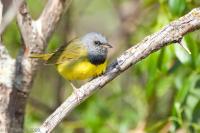 My body had other ideas when I woke it up at 3:30am to go looking for Yellow Rails, so instead a more
sedate 6am departure from Duluth saw me headed for Sax-Zim bog, getting there at 7am just as the
sun emerged from the overcast and the weather cleared. Surely this good weather karma was going to come
to a nasty end soon. I started at Blue Spruce Rd, where activity was unsurprisingly better than the
previous afternoon. Yellow-rumped Warblers, heard then seen Hermit Thrushes and a singing male Blackburnian
Warbler were good starts, then male and female Purple Finch, a singing Mourning Warbler,
Chestnut-sided Warbler, Eastern Wood-Pewee and Eastern Phoebe at the bridge. I heard Veery singing and calling. A Broad-winged Hawk was drying
out in the early morning sun. Chestnut-sided Warbler, Eastern Phoebe and Eastern Wood-Pewee were on the west side of this loop and another
Mourning Warbler was heard.
My body had other ideas when I woke it up at 3:30am to go looking for Yellow Rails, so instead a more
sedate 6am departure from Duluth saw me headed for Sax-Zim bog, getting there at 7am just as the
sun emerged from the overcast and the weather cleared. Surely this good weather karma was going to come
to a nasty end soon. I started at Blue Spruce Rd, where activity was unsurprisingly better than the
previous afternoon. Yellow-rumped Warblers, heard then seen Hermit Thrushes and a singing male Blackburnian
Warbler were good starts, then male and female Purple Finch, a singing Mourning Warbler,
Chestnut-sided Warbler, Eastern Wood-Pewee and Eastern Phoebe at the bridge. I heard Veery singing and calling. A Broad-winged Hawk was drying
out in the early morning sun. Chestnut-sided Warbler, Eastern Phoebe and Eastern Wood-Pewee were on the west side of this loop and another
Mourning Warbler was heard.
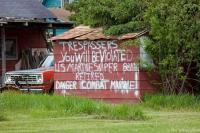 After Blue Spruce Rd I revisited the meadows on Rt.29 north of Meadowlands but had no success with Le Conte's Sparrow,
didn't manage to be totally certain I was seeing the singing (Eastern Meadowlark), and headed up Owl Ave to the intersection with
Mottonen Rd stopping briefly to track down a Clay-colored Sparrow en route.
Like magic, I heard a somewhat distant (Connecticut Warbler) to the west of Owl Ave at Mottonen along with
Magnolia Warbler, Alder Flycatcher, Common Yellowthroat, Nashville Warbler.
Half a mile to the north a Mourning Warbler was singing with the right pitch but a Connecticut Warbler cadence. Some confusion was
cleared up when I actually saw the bird which turned out to be a Mourning Warbler.
Along Arkola Road I added Olive-sided Flycatcher - initial qualms about relative size were abated once one of the
ubiquitous Alder Flycatchers perched just below it.
After Blue Spruce Rd I revisited the meadows on Rt.29 north of Meadowlands but had no success with Le Conte's Sparrow,
didn't manage to be totally certain I was seeing the singing (Eastern Meadowlark), and headed up Owl Ave to the intersection with
Mottonen Rd stopping briefly to track down a Clay-colored Sparrow en route.
Like magic, I heard a somewhat distant (Connecticut Warbler) to the west of Owl Ave at Mottonen along with
Magnolia Warbler, Alder Flycatcher, Common Yellowthroat, Nashville Warbler.
Half a mile to the north a Mourning Warbler was singing with the right pitch but a Connecticut Warbler cadence. Some confusion was
cleared up when I actually saw the bird which turned out to be a Mourning Warbler.
Along Arkola Road I added Olive-sided Flycatcher - initial qualms about relative size were abated once one of the
ubiquitous Alder Flycatchers perched just below it.
Then north along McDavitt Rd where I stopped briefly at the conifer bog ~3 mi north of Sax Rd to listen to a Black-and-white Warbler song, then saw Boreal Chickadee and hung out there long enough to hear a very strange Woodpecker call. Non Hairy-like. I'd already done some research on the relative calls (and disagree with Sibley's descriptions of them). Advancing down the road on the suspicion that it could be Black-backed, I saw a male Black-backed Woodpecker fly past me down McDavitt and into the forest. No luck on further searching, but this was an eye-level view of a roadside fly-by so pretty much unambiguous. I struck out on a possible Yellow-bellied Flycatcher that I couldn't see, and further searching of reported Connecticut Warbler spots turned up nothing. By now it was noon, however and it was time to head west. I think Connecticut Warbler was reported from this section of Owl Ave around the same time as I was there, but I certainly didn't hear it.
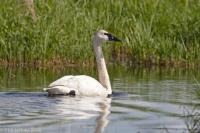 I started the long drive south west in which I skipped the optional site of Itasca SP (BBWP spot), but cut through
Tamarac NWR where the birding drive held Trumpeter Swan, Common Loon and a host
of eastern deciduous species including (Yellow Warbler), (American Redstart), (Veery), (Great-crested Flycatcher),
Least Flycatcher, (Northern Parula) etc. I didn't spend much time walking the drive to find most of the species since I was on a tight schedule.
Exiting Tamarac it was just some quick road miles down out of the deciduous rolling hills around Detroit Lakes and into the very flat agricultural land
beyond Fergus Falls. I crossed into ND via Breckenridge, adding Horned Lark as the last MN bird.
I started the long drive south west in which I skipped the optional site of Itasca SP (BBWP spot), but cut through
Tamarac NWR where the birding drive held Trumpeter Swan, Common Loon and a host
of eastern deciduous species including (Yellow Warbler), (American Redstart), (Veery), (Great-crested Flycatcher),
Least Flycatcher, (Northern Parula) etc. I didn't spend much time walking the drive to find most of the species since I was on a tight schedule.
Exiting Tamarac it was just some quick road miles down out of the deciduous rolling hills around Detroit Lakes and into the very flat agricultural land
beyond Fergus Falls. I crossed into ND via Breckenridge, adding Horned Lark as the last MN bird.
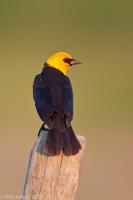 Entering ND at Wahpeton, House Sparrow, Common Grackle, Red-winged Blackbird, Killdeer, and other roadside birds
started out my ND list. I followed ND-13 out to Milnor, located the uninspiring rest area referenced by the
Zen & Art of Motorcycle Maintenance fandom, but at the nearby pond on the south
side of town added prairie birds quickly: Black Tern, Blue-winged Teal, Northern Shoveler, Mallard,
Gadwall, Canvasback, Redhead, American Coot, Yellow-headed Blackbird, Savannah Sparrow. Going through Milnor I saw
Chipping Sparrow and heard (Chimney Swifts). Going north out of Milnor
I went east on 75th for 6 mi east of (Route 10?) then 2 miles north to the Nature Conservancy
wetlands at Sheyenne National Grasslands
for Upland Sandpiper and Marbled Godwit but I didn't find any Le Conte's or Nelson's Sharp-tailed Sparrows. I think
this is the area of Brown Ranch but I didn't attempt to find it.
Further north still along ?10? I added Grasshopper Sparrow and Western Meadowlark at the grasslands trail parking lot but since there was a
dog hanging around it was difficult to approach them.
Entering ND at Wahpeton, House Sparrow, Common Grackle, Red-winged Blackbird, Killdeer, and other roadside birds
started out my ND list. I followed ND-13 out to Milnor, located the uninspiring rest area referenced by the
Zen & Art of Motorcycle Maintenance fandom, but at the nearby pond on the south
side of town added prairie birds quickly: Black Tern, Blue-winged Teal, Northern Shoveler, Mallard,
Gadwall, Canvasback, Redhead, American Coot, Yellow-headed Blackbird, Savannah Sparrow. Going through Milnor I saw
Chipping Sparrow and heard (Chimney Swifts). Going north out of Milnor
I went east on 75th for 6 mi east of (Route 10?) then 2 miles north to the Nature Conservancy
wetlands at Sheyenne National Grasslands
for Upland Sandpiper and Marbled Godwit but I didn't find any Le Conte's or Nelson's Sharp-tailed Sparrows. I think
this is the area of Brown Ranch but I didn't attempt to find it.
Further north still along ?10? I added Grasshopper Sparrow and Western Meadowlark at the grasslands trail parking lot but since there was a
dog hanging around it was difficult to approach them.
As night fell I started the long trek to Jamestown where I stayed at a very budget motel.
I added Western Grebe at a large lake near the entrance to Chase Lake NWR where the causeway had young Killdeer and young Marbled Godwit. The adult Killdeer was performing the broken wing display but the Godwits were less hands-on about protecting their somewhat confused juvenile. Both fledgelings were in the road and getting past them was nerve-wracking. Black-backed Night-Herons were in some ponds and I saw fly-by Great Egret and Snowy Egret near Chase Lake, with the latter two not billed as exactly common in ND - perhaps the influence of a wet year or out-of-date bird lists. The road into Chase Lake NWR was in good condition but the grass in the middle of the track scraped against the underside of the car. It's not easy to find places to turn around along this road and it would be extra fun to meet someone coming in the other direction. I saw Clay-colored Sparrow, Savannah Sparrow and several Grasshopper Sparrows but a notable absence of Baird's or Sprague's Pipit which were the main targets for this place. American White Pelicans were fly-overs.
By now it was late morning and getting too hot to be good for finding much. Checking the area around the nearby Chicago Lake added nothing (previous ND list report suggested this was useful) Crop dusting was happening nearby which didn't help but the time of day was the killer.
In the heat of the day I drove west to Tuttle where the marsh east of town had American Avocet, Green-winged Teal, more Wilson's Phalaropes and White-rumped Sandpipers as well as the usual suspects in the duck department. There were a couple of Chestnut-collared Longspurs in state land used for grazing south-east of town, Orchard Oriole west of town and Josephine Lake had Double-crested Cormorants, Forster's Tern and Willet. Grasslands had Red-tailed Hawk and Northern Harrier but raptor numbers were pretty low and American Kestrels were conspicuous by their absence, especially compared to MN where they were quite numerous.
I then drove a fair distance due north to Bottineau and the Turtle Mountains finding Red-necked Grebes, Baltimore Oriole, Yellow Warbler at School Section lake and other heard several other eastern deciduous birds (Common Raven, Least Flycatcher, American Redstart, Northern Waterthrush were all heard). Black-billed Magpie was a nice addition. Heavy rain in the Turtle Mountains abruptly truncated birding there so I headed back down to the plains. Down to Bottineau to check in at the Super8 and then to J. Clark Salyer NWR where Eared Grebe was fairly common and there were all sorts of ducks including American Wigeon, lots of blackbirds, Tricolored Heron (ND review list), Black-crowned Night-Heron, the motherload of Franklin's Gulls hunting over the marsh, many vocal Marsh Wrens, Black Tern and Forster's Tern. An American Bittern was at the side of the auto tour trail but slunk back into the reeds as I approached. Apparently the Le Conte's habitat here is flooded but I failed to find the recently-reported Nelson's Sharp-tailed Sparrows either. The nearby Grasslands Section west of Kramer held Western Meadowlark, Bobolink, Savannah and Clay-colored Sparrows. The gate was open but the road closed off 1 mile in making for an "interesting" U-turn in the narrow grassy track. Stuart Healey reported one Baird's that was difficult to find in this section around the same time, but given that Baird's are a lot easier in Lostwood this grassland did not seem that productive.
Overnight Super8 at Bottineau.
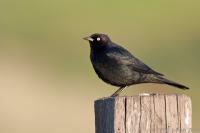 I started early at the road north of Lords Lake NWR, finding Grasshopper and Savannah Sparrows almost immediately, and while striking
out yet again on Le Conte's and Nelsons's I first heard then tracked down a singing Baird's Sparrow - most unexpected. The habitat seemed rather
more lush than I would have associated with Baird's but perhaps it was the best compromise for that area. The bird was distant so plumage
details were useless beyond the fact that it had a little streaking and didn't appear to be an orange-ish Ammodramus,
but I could watch it sing in the scope and hear the song with a half-second delay. A life bird that got put on the "better
view desired" list immediately.
There were one or two Sharp-tailed Grouse along the road and Marbled Godwit. There were a few ducks including Bufflehead on Lords Lake itself.
Driving down a few agricultural roads west of Bottineau I did not find any Gray Partidge, but after checking out of the hotel and taking back roads
toward J. Clark Salyer NWR I found two Gray Partridges a few miles north-east of Kramer after I stopped to take photos of Franklin's Gulls. This
was near one of the small grain silos that dot the area. However given the amount of back-road driving I did, seeing only two was not an outstanding
total. These were also the only two for the entire trip. Two life birds for the morning. Not bad.
I started early at the road north of Lords Lake NWR, finding Grasshopper and Savannah Sparrows almost immediately, and while striking
out yet again on Le Conte's and Nelsons's I first heard then tracked down a singing Baird's Sparrow - most unexpected. The habitat seemed rather
more lush than I would have associated with Baird's but perhaps it was the best compromise for that area. The bird was distant so plumage
details were useless beyond the fact that it had a little streaking and didn't appear to be an orange-ish Ammodramus,
but I could watch it sing in the scope and hear the song with a half-second delay. A life bird that got put on the "better
view desired" list immediately.
There were one or two Sharp-tailed Grouse along the road and Marbled Godwit. There were a few ducks including Bufflehead on Lords Lake itself.
Driving down a few agricultural roads west of Bottineau I did not find any Gray Partidge, but after checking out of the hotel and taking back roads
toward J. Clark Salyer NWR I found two Gray Partridges a few miles north-east of Kramer after I stopped to take photos of Franklin's Gulls. This
was near one of the small grain silos that dot the area. However given the amount of back-road driving I did, seeing only two was not an outstanding
total. These were also the only two for the entire trip. Two life birds for the morning. Not bad.
I walked into the Clark Salyer NWR grasslands section for half a mile but it was relatively quiet with just Bobolink and Savannah Sparrow and the most interesting birds were two fly-by American Bitterns. On the auto tour through the reserve I added pretty much the same birds as the previous day: Black and Forster's Tern, White-faced Ibis, Marsh and (Sedge) Wrens, Willow and Least Flycatchers, Sora. I walked into the sandhill section and wadered around, finding Eastern Bluebird, Veery, Yellow-bellied Sapsucker, Lark Sparrow, Clay-colored Sparrow, (Warbling Vireo), (Ovenbird), Cedar Waxwings, Yellow Warbler and House Wren. There was also a Bald Eagle on the nest a little east of this section. Biting insects were only bad in the dark areas of riparian woodland.
En route south and west to Minot I added another Sharp-tailed Grouse and Upland Sandpiper but precious little else of interest despite a fair amount of driving on back roads. I took lunch at Minot, and checked into an uninspiring but entirely adequate Super8. North out of Minot I went first to Upper Souris NWR which had Purple Martin, Orchard Oriole, Yellow Warbler and Warbling Vireo at the HQ but very little along the auto loop to detain me. Then west to Carpio and US-52 north to Kenmare where I found the Des Lacs NWR visitor center offering very little information as to the tour loop, so I had to rely on road signs. The loop is more of a linear drive along a narrow road of variable quality and only intermittent view of the water, but there were many Eared and some Western Grebes, many waterfowl, a lot of Clay-colored Sparrows and Yellow Warblers along the road with a few Marsh Wrens down by the water. I saw a bird that might have been a Bullock's Oriole, and also a Broad-winged Hawk blasting through the canopy.
Finally I made it to Lostwood NWR in more favorable light in later afternoon. Savannah, Vesper and Clay-colored Sparrows were fairly numerous with especially the Vespers fond of feeding in the road. A couple of Marbled Godwits dive-bombed my car, Willets were less assertive and there were Wilson's Phalarope on the first pond. On the larger alkaline lake were American Avocet, more Phalaropes and Piping Plover. Two local birders scouting for the upcoming ABA convention in Minot (that I was anxious to avoid because I loathe birding crowds) told me about some relatively retiring Nelsons Sharp-tailed Sparrows in the wet marsh downhill from the fire tower that actually sang for us after a little wait. I also saw/heard 2-3 Bairds including one seen well near the grouse blind (stop #11). I also saw another Ammodramus sparrow that was probably a Le Conte's but too briefly to be certain about it. Sprague's Pipits were neither seen nor singing at that time of day.
Overnight Minot (but should have stayed in Kenmare).
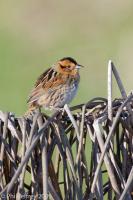 I went to Lostwood NWR at dawn. Baird's Sparrow was singing elusively but there were several individuals from points #11 to #14.
Sprague's Pipits were also around the grouse blind but took some finding until I adopted the old Skylark technique of gridding the sky
when they weren't nearly as impossible to find with binoculars. Pretty invisible to the naked eye. There were two more Sprague's at the
Fire Tower. Grasshopper, Clay-colored, Savannah, Vesper and Song Sparrows were also in evidence, with Least and Willow Flycatchers plus
Warbling Vireos at the willow and alder patches. The two singing Nelson's Sharp-tailed Sparrows were still present at the marsh below the
fire tower but once again there were no traces of Le Conte's. One of the Nelson's was uncharacteristically cooperative and sat on a reed-covered
barbed wire fence while singing. Contrary to what you might think, I did not tape this bird in, but the competition between the singing males
and the ability to sit on location for an extended time without other birders around certainly were factors. Even on a Sunday Lostwood is largely
deserted.
I went to Lostwood NWR at dawn. Baird's Sparrow was singing elusively but there were several individuals from points #11 to #14.
Sprague's Pipits were also around the grouse blind but took some finding until I adopted the old Skylark technique of gridding the sky
when they weren't nearly as impossible to find with binoculars. Pretty invisible to the naked eye. There were two more Sprague's at the
Fire Tower. Grasshopper, Clay-colored, Savannah, Vesper and Song Sparrows were also in evidence, with Least and Willow Flycatchers plus
Warbling Vireos at the willow and alder patches. The two singing Nelson's Sharp-tailed Sparrows were still present at the marsh below the
fire tower but once again there were no traces of Le Conte's. One of the Nelson's was uncharacteristically cooperative and sat on a reed-covered
barbed wire fence while singing. Contrary to what you might think, I did not tape this bird in, but the competition between the singing males
and the ability to sit on location for an extended time without other birders around certainly were factors. Even on a Sunday Lostwood is largely
deserted.
Exiting Lostwood, I went west to Lake Zahl NWR where I found Clay-colored, Grasshopper, (Baird's) Sparrows and Sprague's Pipit - the latter two obviously quite widespread in the right habitat. At nearby Alkali Lake there was a FWS staff member walking the shore line so I put up with distant American Avocet and Wilson's Phalarope views.
 Then south to Roosevelt National Park north section after lunch in Watford City.
Conditions were windy and hot so I saw relatively little although
it was obvious there was a transition to more western species: Western Meadowlark, singing Lazuli Bunting, singing Spotted Towhee
and a few Buffalo. There was a Wood Duck in the flooded woodland bottomland, although at least this was better habitat than the one I saw in a small
flooded woodland in the middle of the prairie on the way to Chase Lake two days previously.
Because of lack of enthusiasm, conditions and the necessary road miles I skipped the secondary sites around Shirley, MT and headed straight to
Glendive, MT via US-85 and I-94 and a scenery stop at Painted Canyon, just west of Belfield and part of the southern section of Theodore
Roosevelt NP.
Then south to Roosevelt National Park north section after lunch in Watford City.
Conditions were windy and hot so I saw relatively little although
it was obvious there was a transition to more western species: Western Meadowlark, singing Lazuli Bunting, singing Spotted Towhee
and a few Buffalo. There was a Wood Duck in the flooded woodland bottomland, although at least this was better habitat than the one I saw in a small
flooded woodland in the middle of the prairie on the way to Chase Lake two days previously.
Because of lack of enthusiasm, conditions and the necessary road miles I skipped the secondary sites around Shirley, MT and headed straight to
Glendive, MT via US-85 and I-94 and a scenery stop at Painted Canyon, just west of Belfield and part of the southern section of Theodore
Roosevelt NP.
Overnight at Super8 in Glendive.
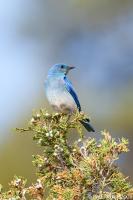 Mostly a long drive day, I started at Makoshika State Park in the badlands just to the south of Glendive.
There I found a nice variety
of birds in overcast conditions: Mountain Bluebird, House Finch, Rock Wren, Cedar Waxwing, Grasshopper, Chipping, Vesper, Field and Lark Sparrows,
American Robin, Prairie Falcon flying up valley, two Wild Turkeys, Spotted Towhee, Western Meadowlark and Say's phoebe.
Mostly a long drive day, I started at Makoshika State Park in the badlands just to the south of Glendive.
There I found a nice variety
of birds in overcast conditions: Mountain Bluebird, House Finch, Rock Wren, Cedar Waxwing, Grasshopper, Chipping, Vesper, Field and Lark Sparrows,
American Robin, Prairie Falcon flying up valley, two Wild Turkeys, Spotted Towhee, Western Meadowlark and Say's phoebe.
The forecast called for patchy sun with thunderstorms and this was certainly the case with large storms dropping water across the landscape with sunny intervals in between them. I headed south-west along I-94 for a bit of long-haul driving. En route there were a few Lark Buntings and a couple of American Kestrels. Stopping outside Miles City at Strawberry Hill BLM I found the usual suspects: Brewer's Blackbird, (Yellow Warbler), Spotted Towhee, Lazuli Bunting. Further driving west on I-94 and then I-90 I finally turned south into the river valley toward Red Lodge, seeing American Kestrel and Northern Flicker along this riparian route and Pine Siskin as I checked into Yodeler Motel in Red Lodge. This small town reminded me a little of Steamboat CO and was clearly geared up to cater to the winter ski trade with a ski lift up to Beartooth Pass to the south. In fact after checking in I headed up there myself.
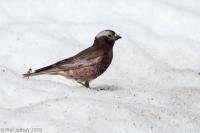 Up toward Beartooth Pass I hit my first montane habitat of the trip and
added Clark's Nutcracker, Mountain Chickadee and Common Raven to the MT list at the Rock Creek Vista, then Black Rosy-Finch,
American Pipit and Horned Lark just before the east summit on the MT side of the state line. The Rosy-Finches were fairly numerous (30+) feeding in
the melting snow fields. Later I added Black Rosy-Finch and American Pipit on the west side of the west summit to the WY list.
There was a decent amount of snow present, with snow walls
up to 10 feet in places and snow persisting down into the "Top of the World" alpine area in WY down off the west summit.
Two Red-tailed Hawks were in this valley. Several lakes were still at least partially frozen. Beartooth Lake was
barely unfrozen but the campsite road was closed and not particularly productive as a walk-in. In fact many facilities like campsites were closed in this
particular National Forest (Shoshone?). The storms appeared to be gathering in greater numbers
and it was relatively cool and wet. Down into the very small and rustic Cooke City the road deteriorated just west of there, so I turned around just
shy of the Yellowstone north-east entrance where it looked like the weather was closing in. Trying to avoid the storm I headed quickly back east to the
junction with Chief Joseph highway where rain storms appeared to be converging. I made rapid stops at sagebrush and aspen areas along the road as I
made my way back toward Beartooth Pass, seeing Hairy Woodpecker,
American Robin, White-crowned Sparrow, Empidonax sp (probably Dusky), and Mountain Bluebird. Further east
at a bog were Green-winged Teal, Mallard, American Robin, Mountain Chickadee, (Hermit Thrush) and full breeding-plumaged male Audubon's
Yellow-rumped Warbler. I made it back over the pass in a snow storm and then down quickly into Red Lodge for the night.
Up toward Beartooth Pass I hit my first montane habitat of the trip and
added Clark's Nutcracker, Mountain Chickadee and Common Raven to the MT list at the Rock Creek Vista, then Black Rosy-Finch,
American Pipit and Horned Lark just before the east summit on the MT side of the state line. The Rosy-Finches were fairly numerous (30+) feeding in
the melting snow fields. Later I added Black Rosy-Finch and American Pipit on the west side of the west summit to the WY list.
There was a decent amount of snow present, with snow walls
up to 10 feet in places and snow persisting down into the "Top of the World" alpine area in WY down off the west summit.
Two Red-tailed Hawks were in this valley. Several lakes were still at least partially frozen. Beartooth Lake was
barely unfrozen but the campsite road was closed and not particularly productive as a walk-in. In fact many facilities like campsites were closed in this
particular National Forest (Shoshone?). The storms appeared to be gathering in greater numbers
and it was relatively cool and wet. Down into the very small and rustic Cooke City the road deteriorated just west of there, so I turned around just
shy of the Yellowstone north-east entrance where it looked like the weather was closing in. Trying to avoid the storm I headed quickly back east to the
junction with Chief Joseph highway where rain storms appeared to be converging. I made rapid stops at sagebrush and aspen areas along the road as I
made my way back toward Beartooth Pass, seeing Hairy Woodpecker,
American Robin, White-crowned Sparrow, Empidonax sp (probably Dusky), and Mountain Bluebird. Further east
at a bog were Green-winged Teal, Mallard, American Robin, Mountain Chickadee, (Hermit Thrush) and full breeding-plumaged male Audubon's
Yellow-rumped Warbler. I made it back over the pass in a snow storm and then down quickly into Red Lodge for the night.
After a few uneventful stops at alder grove sites I drove through Cooke City MT, and was delayed by traffic construction into Yellowstone NP's north-east entrance. At least I got to watch a White-crowned Sparrow hop along the road as I waited. A ranger saved us some time by checking passes etc as we waited and I learnt from him about a Great Gray Owl that was being seen at Floating Island Lake - doubtless dawn or dusk would have been the best time to look for this bird. Once through the entrance gate there was a veritable convoy downhill so I baled out at the Pebble Creek trail pullout and a short walk through sagebrush next to a conifer forest yielded Green-tailed Towhee, Warbling Vireo (finally saw one), (Ruby-crowned Kinglet). I saw a single male Common Merganser along Soda Butte Creek. Vesper Sparrow was in the valley as it opened up into sagebrush but I didn't find Brewer's Sparrow.
Many Buffalo were present as the Lamar Valley widened, including a group that crossed the road at Soda Butte itself followed by a flock of Brewer's Blackbirds. I saw one Pronghorn that had not yet attracted attention, which was somewhat of a miracle given the general human behavior in Yellowstone. At the next pullout the Cliff Swallows were nesting at the restrooms and Bank Swallows flew by. There were a remarkable number of Buffalo littered across this broad grassy valley (Lamar Valley), Common Raven wandered up and down the valley and a couple of Red-tailed Hawks were seen near Slough Creek. While searching unsuccessfully for Brewer's Sparrow I did at least turn up Sage Thrasher, and while failing to find Goldeneyes I saw a Spotted Sandpiper and a few E. Starlings. The first Osprey of the trip flew overhead calling. Cinnamon Teal was found in a couple of the calmer areas along the river.
I took the side road to Slough Creek campground and at the pullout overlooking the creek saw Green-winged Teal, Yellow-headed Blackbird, Black-backed Magpie, a female Goldeneye sp. with a dark bill (see later - Barrow's females have dark bills at the height of breeding plumage), a sleeping swan (should be Trumpeter) and American Wigeon.
A little further along the Slough Creek road, but short of the campground, I took a trail along a small stream which turned out to be very productive. Several vocal Pine Siskins and a pair of Williamson's Sapsuckers were the first finds. Then a large raptor drew my interest, and I was overjoyed to find it was an adult Northern Goshawk which had prey in its talons but was in no apparent hurry and was in full view circling for several minutes. Lincoln's Sparrow, Audubon's Yellow-rumped Warbler, MacGillivray's Warbler, House Wren, Ruby-crowned Kinglet, Warbling Vireo and Cassin's Finch were also present. I gave up on the trail when a storm rolled in. There was an Empidonax here that could have been either Hammond's, Cordilleran or Dusky but it was totally silent and I had no desire to open that can of worms with so little recent experience with them in a habitat which could suit any of the three.
Traveling down the river I didn't find anything else new, and at Tower Junction I headed west toward Gardiner to check out Floating Island Lake, where indeed there was a floating island and a Sandhill Crane nesting on it ! Then I pulled out at Blacktail Plateau Drive and found it closed. Nevertheless I parked and walked in for a while and saw Williamson's Sapsucker, Northern Flicker, Yellow-rumped Warbler, Dark-eyed Junco. More interesting were three Coyotes that loped along 100 yards away and largely ignored me. I turned around on the road when it became somewhat obvious that no other alder groves were appearing, but before I did I managed to find a Dusky Flycatcher. The human behavior at Yellowstone is fundementally parasitic, where the traffic slows to a halt whenever someone appears to have found something interesting, and all sorts of gratuitously touristic behavior then manifests. This can reach silly heights, and I precipitated one myself with the help of a British (presumed) birding group. At the start I was the only one parked at the start of the closed Blacktail Drive, and then the British group van parked behind me. I bumped into them walking up the trail as I walked back down it as they were engrossed in examining some Wolf scat. This number of people precipitated the "must be something good" parasitic behavior where suddenly all sorts of tourists pulled off the road and wandered up to me asking what was there. Clearly this is the way to go if you want to perpetrate a full-blown hoax (claiming a Grizzly 300 yards up the trail would be an excellent story). Nevertheless this sort of behavior is not idyllic and might be viewed by some (e.g. me) as farcical.
Returning to Tower Junction I headed south toward Canyon, and apparently everyone else had the same idea, with many pullouts jammed with cars, and one "bear jam" where two Black Bears (a brown-colored one was being mis-ID'd as a Grizzly). So I skipped the worst of them (e.g. Tower Falls) that were swarming with tourists. I got a very late lunch at Canyon and carried on south toward Hayden Valley. There weren't many big mammals there, and the Yellowstone River that drained Yellowstone Lake looked swollen and fast upstream of the canyon falls near Canyon. I noticed Western Grebe from the roadside. In a wider section in Hayden Valley a few American Avocet and Wilson's Phalarope were present along with California Gull. There were decent numbers of Canada Geese. But I wasn't finding any Goldeneyes.
Finally I made it to Yellowstone Lake and found a pullout where a flock of male, immature male and one or two apparent female Barrow's Goldeneye's were feeding. The "females" had all dark bills so I'm not sure of both their gender and the reliability of that ID feature - allegedly Barrow's have small yellow bills as females. A few Scaup sp. and a pair of Buffleheads were also present. I carried on through to Grand Teton NP in the face of time marching on, storms wandering around the mountain valleys, more road construction and a growing sense of exhaustion. Finally reaching Grand Teton NP I saw an American White Pelican below the dam. The small lake nearby was closed because of Trumpeter Swan breeding activity with no clear visibility from the road. I actually got better Trumpeter Swan views in MN this trip than in WY. I drove up Signal Mtn in search of the elusive Dusky Grouse. No Grouse, but there were Rock Wren, Western Tanager, (Swainson's Thrush), (Hermit Thrush), (Ruby-crowned Kinglet), Audubon's Yellow-rumped Warbler, a single Townsend's Solitaire and Red-tailed Hawk as dusk fell. Overnight (and some laundry) at one of the better Motel6's I stayed at all trip, in Jackson, with a price tag to match ($75). Jackson's a good tourist town with many restaurant options and lurks as a triplet with Red Lodge (MT) and Steamboat (CO) as places that might be good to explore when not on some crazy birding trip. The 20-something check-in clerk at the Motel6 asked me if I was a member of AARP, so it was possible that the successive early mornings were getting to me. (I was 45 when I took this trip).
 Down to the Jenny Lake scenic drive to take advantage of the sunny morning, I then hiked the trail to Taggart Lake through some very promising
habitat for Ruffed Grouse - finding Yellow Warbler, Dusky Flycatcher, (Western Wood-Pewee),
several Chipping Sparrows, Pine Siskin, displaying Broad-tailed Hummingbird. The trail crossed two streams and paralleled the second one
up through the alders to an open scrubbier patch for another Dusky Flycatcher, then into a young pine grove (post-burn) for Clark's Nutcracher,
(Swainson's Thrush), Dark-eyed Junco until it reached Taggart Lake - where Swainson's and Hermit Thrushes were singing, and a Coyote was
encountered jogging down the trail.
Down to the Jenny Lake scenic drive to take advantage of the sunny morning, I then hiked the trail to Taggart Lake through some very promising
habitat for Ruffed Grouse - finding Yellow Warbler, Dusky Flycatcher, (Western Wood-Pewee),
several Chipping Sparrows, Pine Siskin, displaying Broad-tailed Hummingbird. The trail crossed two streams and paralleled the second one
up through the alders to an open scrubbier patch for another Dusky Flycatcher, then into a young pine grove (post-burn) for Clark's Nutcracher,
(Swainson's Thrush), Dark-eyed Junco until it reached Taggart Lake - where Swainson's and Hermit Thrushes were singing, and a Coyote was
encountered jogging down the trail.
Returning back down the trail I found the same species and more hikers, so I completed my second strike-out for the morning on grouse. I went to the Jenny Lake Burn which had pretty much no woodpeckers except a few Northern Flickers, one American Kestrel, Chipping and White-crowned Sparrows, MacGillivray's Warbler, Brown Creeper, Western Wood-Pewee, (Olive-sided Flycatcher), Western Tanager, Black-headed Grosbeak, a fly by immature Bald Eagle, an Osprey nest, and a few Common Mergansers along the lake. That's a good list, bracketed either side of a short hail storm from one of the storms that continued the stormy-and-sunny trend of the previous day. However the actual target was woodpeckers, and I only heard two Hairies. This might reflect the fact that it's not a recent burn, so that it's "played out", or that I should have started there first rather than mid-morning.
Back toward Jackson I saw Trumpeter Swan, Gadwall, Ring-necked Duck at the river overlook on the north side of town. After lunch and a short rest at the hotel I decided to hit a few trails in the later afternoon in search of primarily Ruffed Grouse. I went to the Death Valley trailhead off Moose-Wilson Rd, which was a relatively rough road but just traversable by passenger car (the sign recommended 4-wheel drive, but the conditions at the time were mostly dry). The Valley Trail northbound was flat and went through excellent habitat for Ruffed Grouse - but there were none to be found. A plus was the fact that hikers weren't to be found either. Instead I did find more Swainson's Thrushes, Williamson's Sapsucker, Ruby-crowned Kinglet, Yellow-rumped Warbler and Dark-eyed Junco. Along the edge of the parking lot at Lupine Trail many Elk were gathering. I followed the paved trail and saw Swainson's Thrush, fly-by Great Blue Heron and adult Bald Eagle. It was getting fairly dark, fairly late and lightly drizzling, perhaps not the best conditions to find anything. Nevertheless I made a stab at the Taggart Lake trail, hiking to the second stream crossing and a little way up into the aspens, but saw a subset of the morning's species and no grouse. I was 0/3 at this point for target species for the day.
It was already sunset and was quite murky out but I made the 18 minute drive north to Signal Mountain once more, in the distant hope of Dusky Grouse. Climbing the mountain I had my headlights on, and increasingly needed them to see to drive in the pine forest. Up at the top, around the last corner, I slowed down thinking that if there was a Dusky in the road it would be a shame to hit it. And there it was, in the middle of the road, wandering down toward me through my headlight beams. I parked up along the side of the road 75 yards away and proceeded to watch it sing in dark conditions by the side of the road before it wandered off into the brush. When I say "sing" I mean give a series of barely audible ultra-low pitch hoots. Quite the finale for the day.
Overnight Jackson Motel6 for second night.
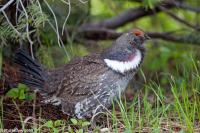 I returned to Signal Mtn at dawn and initially thought I'd failed to find the Dusky Grouse until I noticed it sheltering under a conifer from
the rain, singing again. It sat there for a while hooting away as I shot about 200 images of it in impossibly dark conditions requiring
high ISO - the picture at left was shot at ISO 1600 at something absurd like 1/30th at f4. The inherent sharpness of the EOS 5D Mark II and the 500/4L
helps to overcome the noise in the image, especially after using Noise Ninja. Elk and Mule Deer were feeding in the forest, and there was the mostly the same mix of birds as the previous days visits there. This Dusky Grouse was unquestionably the bird of the trip, even edging out that Northern Goshawk.
I returned to Signal Mtn at dawn and initially thought I'd failed to find the Dusky Grouse until I noticed it sheltering under a conifer from
the rain, singing again. It sat there for a while hooting away as I shot about 200 images of it in impossibly dark conditions requiring
high ISO - the picture at left was shot at ISO 1600 at something absurd like 1/30th at f4. The inherent sharpness of the EOS 5D Mark II and the 500/4L
helps to overcome the noise in the image, especially after using Noise Ninja. Elk and Mule Deer were feeding in the forest, and there was the mostly the same mix of birds as the previous days visits there. This Dusky Grouse was unquestionably the bird of the trip, even edging out that Northern Goshawk.
This was mostly planned on being a Tetons-Yellowstone-and-eastward day, and the weather wasn't particularly friendly with low cloud and frequent patches of rain. For one last attempt at Ruffed Grouse I was the first person on the Taggart Lake trail finding a subset of species from the previous day but Ruffed Grouse were conspicuous by their absence. The rain got heavier and I made my way back to the car to drive north to Yellowstone.
In Yellowstone I took the south-west corner to Old Faithful to at least take a look at the scene. Big mistake, as I found it had been turned into a tourist magnet with few redeeming features. The road to Old Faithful even had its own exit ramp although one threatened by some geothermal activity. The old lodge overlooking Old Faithful was huge and magnificent, but the rest of the area had been developed in standard National Park mode to cater to the mass of tourists, rather strongly detracting from the spectacle. . Common Raven was the only bird species I saw at Old Faithful. I exited in a hurry, working my way around the south-east corner as far north as Canyon. Barrow's Goldeneyes were on the Yellowstone Lake, Common Mergansers and Western Grebes were on the Yellowstone River north of there in the Hayden Valley, but apart from scenic stops at Mud Volcano and Lower Canyon Falls I failed to find any interesting bird species in variable weather conditions. In driving rain I did come across an interesting conifer burn near the Hayden Valley but conditions didn't allow me to check it out. Finally I returned to Yellowstone Lake and took the road toward the East Entrance. On the road east of the Fishing Bridge I saw Eared Grebe, Northern Rough-winged Swallow mixed in with Bank and Cliff Swallows. A little further along at Steamboat Point there was a Common Loon along the lake and Violet-green Swallows nesting on the cliffs.
The road through the East Entrance of the park takes you toward Cody along US-20/16/14. As I was dropping out of the mountains as the valley starts to widen at Wapiti I came across a small group of what appeared to be Mountain Goats, walking uphill out of a river valley after either coming down to drink (or perhaps visiting a salt lick). Out of Cody, I followed the US-20/16/14 combination to Greybull and US-14 to Shell into the Bighorn Mountains and up via Granite Pass. The drier conditions between the mountain ranges suggested that this was in the rain shadow of the Rockies. At a small National Forest site along the canyon I stopped to find Lazuli Bunting, Chipping Sparrow, Cassin's Finch and Common Raven streamside. Then up through the the pass into a greener alpine area that would seem to be promising for all sorts of montane birds if it had more public land access - however it appeared to be mostly private land so I didn't stop to investigate. I made good time across the plateau at the top of the Bighorns, exiting the mountain range on the east side and meeting the interstate at Ranchester. I managed to make it as far as Gillette overnight seeing Killdeer, Brewer's Blackbird, Western Meadowlark, Red-tailed Hawk along the interstate.
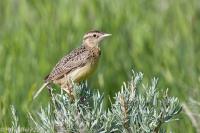 A little after dawn I made it to Lynch Road in Thunder Basin NG west of Newcastle and south of Gillette. There were several Lark Buntings, Western Meadowlarks, Brewer's Sparrows,
and smaller numbers of Sage Thrasher and Killdeer. There were a decent number of Pronghorn in the lusher areas. Despite good numbers of birds the diversity was low, so after a couple of
hours chasing photographs I headed east toward Newcastle through the grasslands. An older trip report had indicated some shortgrass prairie with Chestnut-collared Longspurs along this
route (WY-450) but I didn't see any on the fence lines and it was pretty obvious that the land was all private. Newcastle is on the south-west edge of the Black Hills, and I crossed
into this higher rolling terrain and into SD via US-16, ultimately reaching Custer. My sole target in this region was the productive burn at Four Mile Draw at
Custer State Park so after paying the $6 access fee
I headed straight for it, ignoring other potentially productive places. Several Buffalo were seen roadside. Up at the burn (~3 miles along the Wildlife Drive, 0.5 miles up the dirt
road of Four Mile Draw itself) I sheltered under one of the living trees while a rain storm passed, then finally found some woodpeckers. Two of these turned out to be male Black-backed Woodpeckers !
The rest were Hairies with a some Flickers heard across the valley. Chipping Sparrows and Brewer's Blackbirds were around, and Western Tanager was heard.
A little after dawn I made it to Lynch Road in Thunder Basin NG west of Newcastle and south of Gillette. There were several Lark Buntings, Western Meadowlarks, Brewer's Sparrows,
and smaller numbers of Sage Thrasher and Killdeer. There were a decent number of Pronghorn in the lusher areas. Despite good numbers of birds the diversity was low, so after a couple of
hours chasing photographs I headed east toward Newcastle through the grasslands. An older trip report had indicated some shortgrass prairie with Chestnut-collared Longspurs along this
route (WY-450) but I didn't see any on the fence lines and it was pretty obvious that the land was all private. Newcastle is on the south-west edge of the Black Hills, and I crossed
into this higher rolling terrain and into SD via US-16, ultimately reaching Custer. My sole target in this region was the productive burn at Four Mile Draw at
Custer State Park so after paying the $6 access fee
I headed straight for it, ignoring other potentially productive places. Several Buffalo were seen roadside. Up at the burn (~3 miles along the Wildlife Drive, 0.5 miles up the dirt
road of Four Mile Draw itself) I sheltered under one of the living trees while a rain storm passed, then finally found some woodpeckers. Two of these turned out to be male Black-backed Woodpeckers !
The rest were Hairies with a some Flickers heard across the valley. Chipping Sparrows and Brewer's Blackbirds were around, and Western Tanager was heard.
At this point I made a tactical decision to exit the Black Hills rather than take the slow winding roads north to Spearfish Canyon. In light of what I didn't achieve in Theodore Roosevelt SP that evening, it would have made more sense to spend the time in Spearfish Canyon and head north later - the benefits of hindsight. As it transpired I took a long drive north along US-85 through SD into ND. Roadside birding was less productive in SD because there are no prairie potholes, but I did see a few Lark Buntings south of the border in SD and fewer north of the border in ND. In fact there appeared to be a marked uptick in agricultural land use in ND compared to the similar area in SD. In ND there were more roadside ponds and a Swainson's Hawk.
Finally I made it to Theodore Roosevelt's south unit late in the afternoon and went to the picnic area in Cottonwood Canyon where I found Yellow Warbler, Eastern Bluebird, Lazuli Bunting and a first year male American Redstart. The American Redstart surprised me but it appears to be well within the breeding range. There were no viable photographic opportunities, however. I stayed overnight at the Cowboy Motel in Belfield which had wired internet via satellite.
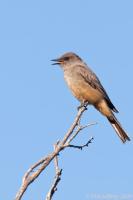 Not long after sunrise on the valley floor I started out at the Cottonwood picnic area at T. Roosevelt NP South and saw Yellow Warbler, Yellow-breasted Chat,
Bullock's Oriole, Spotted Towhee, Eastern Bluebird and Barn Swallow. American Redstarts sang from multiple brushy areas. Field Sparrows sang from the sage brush and so did several
Chats and Lazuli Buntings in mixed Juniper/sage river valleys. Photo ops were less common than I would like with the exception of a single Say's Phoebe
and I left the south unit after covering the river valleys
Not long after sunrise on the valley floor I started out at the Cottonwood picnic area at T. Roosevelt NP South and saw Yellow Warbler, Yellow-breasted Chat,
Bullock's Oriole, Spotted Towhee, Eastern Bluebird and Barn Swallow. American Redstarts sang from multiple brushy areas. Field Sparrows sang from the sage brush and so did several
Chats and Lazuli Buntings in mixed Juniper/sage river valleys. Photo ops were less common than I would like with the exception of a single Say's Phoebe
and I left the south unit after covering the river valleys
By the time I reached Theodore Roosevelt NP north unit it was a redux of conditions on the way to MT - windy and hot. I managed to find (Yellow Warbler), (Rock Wren), an immature Golden Eagle, Spotted Towhee, Western Meadowlark and Say's Phoebe but birding conditions were fairly poor. After driving to the end of the auto tour I left to have lunch in Watford City before heading east then north to Stanley and then onto Lostwood NWR where in windy conditions I found Baird's, Vesper, Savannah and Clay-colored Sparrows, Marbled Godwit, Green-winged Teal, Ruddy Duck, Swainson's Hawk, Northern Harrier and a Sharp-tailed Grouse on the road south of Lostwood NWR. Again, there was no evidence of singing Sprague's Pipit in the afternoon, and I could not find either Nelson's nor Le Conte's Sparrows. Given the conditions I left fairly early for Des Lacs NWR which is precisely when the rental car started to give problems starting, a symptom that would persist through the middle of the next day and may just have been dirt in the fuel line. Nevertheless your rental car refusing to start in rural ND is not the ideal situation.
Overnight in Kenmare.
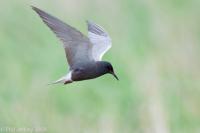 I headed into Minot and then east on US-2 to Berwick where a little rummaging around in the ponds north of this hamlet produced Horned Grebe for the trip list and the usual marshland birds
including Wilson's Phalarope and Black Tern in good numbers. Then I backtracked a little and headed north-west to Clark Salyer NWR where the wind hadn't lessened and parts of the auto
tour had minor grit storms. Black and Forster's Terns handled the conditions well, as did many Franklin's Gulls, with a variety of waterfowl hunkered down in calmer areas. Sora's were heard, but
predictably Ammodramus sparrows were nowhere to be found. After being buffeted by wind all day I made a late afternoon drive to Bismarck without further stops, although as it passed through
the hillier country north of Wing I noted that this had been reported as good territory for Baird's Sparrow and Sprague's Pipit and one could see why - it bore a strong resemblence to the
terrain around Chase Lake NWR a little to the east of there and somewhat like Lostwood NWR.
I headed into Minot and then east on US-2 to Berwick where a little rummaging around in the ponds north of this hamlet produced Horned Grebe for the trip list and the usual marshland birds
including Wilson's Phalarope and Black Tern in good numbers. Then I backtracked a little and headed north-west to Clark Salyer NWR where the wind hadn't lessened and parts of the auto
tour had minor grit storms. Black and Forster's Terns handled the conditions well, as did many Franklin's Gulls, with a variety of waterfowl hunkered down in calmer areas. Sora's were heard, but
predictably Ammodramus sparrows were nowhere to be found. After being buffeted by wind all day I made a late afternoon drive to Bismarck without further stops, although as it passed through
the hillier country north of Wing I noted that this had been reported as good territory for Baird's Sparrow and Sprague's Pipit and one could see why - it bore a strong resemblence to the
terrain around Chase Lake NWR a little to the east of there and somewhat like Lostwood NWR.
Overnight Bismarck at a fairly basic Motel6.
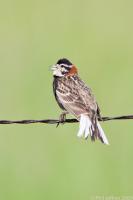 The day started dry but with heavy low cloud and fog that slowly lifted throughout the morning. I started in and round the state lands south-east of Tuttle finding
Chestnut-collared Longspur, Grasshopper Sparrow, Wilson's Snipe, Clay-colored Sparrow, Savannah Sparrow, one briefly heard (Baird's Sparrow), Black Terns,
Western Meadowlark, various waterfowl, Sharp-tailed Grouse, a possible singing Indigo Bunting and an American White Pelican on the lake east of Tuttle. From there I went west
and tracked north along the route of the Carrington Birding Drives. At various stops I found Chestnut-collared Longspur, NO Baird's/Sprague's, another Horned Grebe,
Black Tern, White Pelican, waterfowl, Harrier, RT Hawk with a white tail,
Clay-colored and Savannah Sparrows, Pied-billed Grebe, Upland Sandpiper, Sedge and Marsh Wrens and heard a (Sora).
The day started dry but with heavy low cloud and fog that slowly lifted throughout the morning. I started in and round the state lands south-east of Tuttle finding
Chestnut-collared Longspur, Grasshopper Sparrow, Wilson's Snipe, Clay-colored Sparrow, Savannah Sparrow, one briefly heard (Baird's Sparrow), Black Terns,
Western Meadowlark, various waterfowl, Sharp-tailed Grouse, a possible singing Indigo Bunting and an American White Pelican on the lake east of Tuttle. From there I went west
and tracked north along the route of the Carrington Birding Drives. At various stops I found Chestnut-collared Longspur, NO Baird's/Sprague's, another Horned Grebe,
Black Tern, White Pelican, waterfowl, Harrier, RT Hawk with a white tail,
Clay-colored and Savannah Sparrows, Pied-billed Grebe, Upland Sandpiper, Sedge and Marsh Wrens and heard a (Sora).
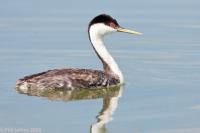 Driving south I went as far as Chase Lake NWR but only walked a short distance along the entrance road. A silent Sprague's Pipit circled in the air before diving into the prairie,
there were Grasshopper and Savannah Sparrows and there were scolding Brewer's Blackbirds. Otherwise nothing to detain me. The causeway across the lake east of here didn't have the
fledgeling Killdeer and Marbled Godwits of the previous week but Western Grebes were in higher numbers. Great and Snowy Egrets were around here. I drove the Jamestown-Chase Lake
birding drive in reverse, finding nothing special in the middle of the day beyond Sedge Wren and Pied-billed Grebe, but there was increased truck traffic compared to the first
time I visited it.
Driving south I went as far as Chase Lake NWR but only walked a short distance along the entrance road. A silent Sprague's Pipit circled in the air before diving into the prairie,
there were Grasshopper and Savannah Sparrows and there were scolding Brewer's Blackbirds. Otherwise nothing to detain me. The causeway across the lake east of here didn't have the
fledgeling Killdeer and Marbled Godwits of the previous week but Western Grebes were in higher numbers. Great and Snowy Egrets were around here. I drove the Jamestown-Chase Lake
birding drive in reverse, finding nothing special in the middle of the day beyond Sedge Wren and Pied-billed Grebe, but there was increased truck traffic compared to the first
time I visited it.
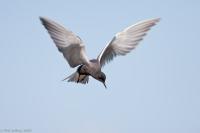 I made a quick check of the WPA near Rogers but despite reports of Le Conte's and Nelson's here there was nothing beyond Savannah Sparrows at 2pm with a good breeze. It's not obvious to me
if the people that post the reports are walking into the areas too, which would explain the high counts, but I'm reluctant to do that in breeding season without a compelling reason. Finding birds for the year list doesn't quite meet that standard.
I made a quick check of the WPA near Rogers but despite reports of Le Conte's and Nelson's here there was nothing beyond Savannah Sparrows at 2pm with a good breeze. It's not obvious to me
if the people that post the reports are walking into the areas too, which would explain the high counts, but I'm reluctant to do that in breeding season without a compelling reason. Finding birds for the year list doesn't quite meet that standard.
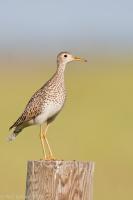 Then I headed south towards Lisbon and Sheyenne NG. Going through Lisbon just after 4pm I decided it was too late to get info about the grasslands so I headed to the
walk in at trail - actually more of a ride-in trail - Grasshopper, Savannah, Clay-colored Sparrows were in the grasslands along with Bobolink and Western Meadowlark. Some of the prairie was
fairly wet, doubtless in view of the recent rains, so I also encountered winnowing Wilson's Snipe, agitated Wilson's Phalarope and Black Terns. Over on the south side of Sheyenne NG
near Brown Ranch the wetlands turned up more Snipe, Upland Sandpiper, American Coots with young, numerous icterids, a heard (Sora) and finally, finally two heard-only Le Conte's Sparrows which were entirely invisible.
Then I headed south towards Lisbon and Sheyenne NG. Going through Lisbon just after 4pm I decided it was too late to get info about the grasslands so I headed to the
walk in at trail - actually more of a ride-in trail - Grasshopper, Savannah, Clay-colored Sparrows were in the grasslands along with Bobolink and Western Meadowlark. Some of the prairie was
fairly wet, doubtless in view of the recent rains, so I also encountered winnowing Wilson's Snipe, agitated Wilson's Phalarope and Black Terns. Over on the south side of Sheyenne NG
near Brown Ranch the wetlands turned up more Snipe, Upland Sandpiper, American Coots with young, numerous icterids, a heard (Sora) and finally, finally two heard-only Le Conte's Sparrows which were entirely invisible.
Overnight Fargo
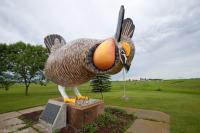 Pretty much no birding was done on this travel day - the day dawned humid, then strong storms developed that eliminated any desire I had to
bird the local prairie areas although I did start to drive there before a heavy storm overtook me.
I started the drive to Minneapolis, stopping briefly at Rothsay to look at the roadside Prairie-Chicken statue,
and by the time I emerged from the car it was breezy in the 90's so I just returned the rental car and
spent the rest of the time in the airport working on photos before the flight back.
Pretty much no birding was done on this travel day - the day dawned humid, then strong storms developed that eliminated any desire I had to
bird the local prairie areas although I did start to drive there before a heavy storm overtook me.
I started the drive to Minneapolis, stopping briefly at Rothsay to look at the roadside Prairie-Chicken statue,
and by the time I emerged from the car it was breezy in the 90's so I just returned the rental car and
spent the rest of the time in the airport working on photos before the flight back.
| Common Loon | Gavia immer | MN |
| Pied-billed Grebe | Podilymbus podiceps | ND |
| Red-necked Grebe | Podiceps grisegena | ND:Turtle Mtns |
| Horned Grebe | Podiceps auritus | ND |
| Eared Grebe | Podiceps nigricollis | ND, WY |
| Western Grebe | Aechmophorus occidentalis | ND, WY |
| American White Pelican | Pelecanus erythrorhynchos | ND, WY |
| Double-crested Cormorant | Phalacrocorax auritus | ND |
| American Bittern | Botaurus lentiginosus | ND |
| Great Blue Heron | Ardea herodias | MN, WY |
| Great Egret | Ardea alba | ND, MN |
| Snowy Egret | Egretta thula | ND |
| Tricolored Heron | Egretta tricolor | ND |
| Green Heron | Butorides virescens | MN |
| Black-crowned Night-Heron | Nycticorax nycticorax | ND |
| White-faced Ibis | Plegadis chihi | ND |
| Turkey Vulture | Cathartes aura | MN, ND, MT |
| Canada Goose | Branta canadensis | MN, ND, WY |
| Trumpeter Swan | Cygnus buccinator | MN, WY |
| Wood Duck | Aix sponsa | MN, ND |
| Gadwall | Anas strepera | ND, WY |
| American Wigeon | Anas americana | ND, WY |
| Mallard | Anas platyrhynchos | MN, ND, WY |
| Blue-winged Teal | Anas discors | ND |
| Cinnamon Teal | Anas cyanoptera | WY |
| Northern Shoveler | Anas clypeata | ND |
| Northern Pintail | Anas acuta | ND |
| Green-winged Teal | Anas crecca | ND, WY |
| Canvasback | Aythya valisineria | ND |
| Redhead | Aythya americana | ND |
| Ring-necked Duck | Aythya collaris | MN, ND |
| Lesser Scaup | Aythya affinis | ND, WY |
| Bufflehead | Bucephala albeola | MN, ND, WY |
| Barrow's Goldeneye | Bucephala islandica | WY |
| Hooded Merganser | Lophodytes cucullatus | ND |
| Common Merganser | Mergus merganser | WY |
| Ruddy Duck | Oxyura jamaicensis | MN, ND |
| Osprey | Pandion haliaetus | WY |
| Bald Eagle | Haliaeetus leucocephalus | MN, ND, WY |
| Northern Harrier | Circus cyaneus | ND |
| Sharp-shinned Hawk | Accipiter striatus | MN |
| Cooper's Hawk | Accipiter cooperii | MN |
| Northern Goshawk | Accipiter gentilis | WY |
| Broad-winged Hawk | Buteo platypterus | MN, ND |
| Swainson's Hawk | Buteo swainsoni | ND |
| Red-tailed Hawk | Buteo jamaicensis | ND, WY |
| Golden Eagle | Aquila chrysaetos | ND |
| American Kestrel | Falco sparverius | MN, MT |
| Prairie Falcon | Falco mexicanus | MT |
| Gray Partridge | Perdix perdix | ND (Life bird) |
| Ring-necked Pheasant | Phasianus colchicus | ND |
| Dusky Grouse | Dendragapus obscurus | WY (Life bird) |
| Sharp-tailed Grouse | Tympanuchus phasianellus | ND |
| Wild Turkey | Meleagris gallopavo | MT |
| Sora | Porzana carolina | ND |
| American Coot | Fulica americana | ND, WY |
| Sandhill Crane | Antigone canadensis | WY |
| Piping Plover | Charadrius melodus | ND |
| Killdeer | Charadrius vociferus | MN, ND, WY |
| American Avocet | Recurvirostra americana | ND, WY |
| Willet | Catoptrophorus semipalmatus | ND |
| Spotted Sandpiper | Actitis macularia | ND, WY |
| Upland Sandpiper | Bartramia longicauda | ND |
| Marbled Godwit | Limosa fedoa | ND |
| White-rumped Sandpiper | Calidris fuscicollis | ND |
| Sanderling | Calidris alba | ND |
| Wilson's Snipe | Gallinago delicata | ND |
| Wilson's Phalarope | Phalaropus tricolor | ND, WY |
| Franklin's Gull | Larus pipixcan | ND |
| Ring-billed Gull | Larus delawarensis | MN |
| California Gull | Larus californicus | ND, WY |
| Herring Gull | Larus argentatus | MN |
| Forster's Tern | Sterna forsteri | ND |
| Black Tern | Chlidonias niger | MN, ND |
| Rock Pigeon | Columba livia | MN, ND, MT |
| Mourning Dove | Zenaida macroura | MN, ND, MT |
| Common Nighthawk | Chordeiles minor | MN |
| Chimney Swift | Chaetura pelagica | (ND), MT |
| Broad-tailed Hummingbird | Selasphorus platycercus | WY |
| Williamson's Sapsucker | Sphyrapicus thyroideus | WY |
| Yellow-bellied Sapsucker | Sphyrapicus varius | MN, ND |
| Hairy Woodpecker | Picoides villosus | MN, MT, WY |
| Black-backed Woodpecker | Picoides arcticus | MN, SD (Life bird) |
| Northern Flicker | Colaptes auratus | MN, ND, MT, WY |
| Pileated Woodpecker | Dryocopus pileatus | MN |
| Olive-sided Flycatcher | Contopus cooperi | MN, WY |
| Western Wood-Pewee | Contopus sordidulus | WY |
| Eastern Wood-Pewee | Contopus virens | MN, ND |
| Alder Flycatcher | Empidonax alnorum | MN |
| Willow Flycatcher | Empidonax traillii | ND |
| Least Flycatcher | Empidonax minimus | MN, ND |
| Dusky Flycatcher | Empidonax oberholseri | WY |
| Eastern Phoebe | Sayornis phoebe | MN, ND |
| Say's Phoebe | Sayornis saya | MT, ND |
| Great Crested Flycatcher | Myiarchus crinitus | MN, ND |
| Western Kingbird | Tyrannus verticalis | ND, MT, WY |
| Eastern Kingbird | Tyrannus tyrannus | MN, ND, MT |
| Yellow-throated Vireo | Vireo flavifrons | (MN) |
| Warbling Vireo | Vireo gilvus | (ND), WY |
| Red-eyed Vireo | Vireo olivaceus | MN, (ND) |
| Gray Jay | Perisoreus canadensis | WY |
| Blue Jay | Cyanocitta cristata | MN |
| Clark's Nutcracker | Nucifraga columbiana | MT, WY |
| Black-billed Magpie | Pica hudsonia | ND, MT, WY |
| American Crow | Corvus brachyrhynchos | MN, ND, MT, WY |
| Common Raven | Corvus corax | MN, (ND), MT, WY |
| Horned Lark | Eremophila alpestris | MN, ND, MT, WY |
| Purple Martin | Progne subis | ND |
| Tree Swallow | Tachycineta bicolor | MN, ND, WY |
| Violet-green Swallow | Tachycineta thalassina | MT, WY, ND |
| Northern Rough-winged Swallow | Stelgidopteryx serripennis | WY |
| Bank Swallow | Riparia riparia | ND, WY |
| Cliff Swallow | Petrochelidon pyrrhonota | MN, ND, MT, WY |
| Barn Swallow | Hirundo rustica | MN, ND, MT |
| Black-capped Chickadee | Poecile atricapilla | MN |
| Mountain Chickadee | Poecile gambeli | MT, WY |
| Boreal Chickadee | Poecile hudsonica | MN |
| Red-breasted Nuthatch | Sitta canadensis | (MN), WY |
| White-breasted Nuthatch | Sitta carolinensis | SD |
| Brown Creeper | Certhia americana | WY |
| Rock Wren | Salpinctes obsoletus | MT, WY |
| House Wren | Troglodytes aedon | (ND), (MT), WY |
| Sedge Wren | Cistothorus platensis | MN, ND |
| Marsh Wren | Cistothorus palustris | ND |
| Ruby-crowned Kinglet | Regulus calendula | WY |
| Eastern Bluebird | Sialia sialis | MN, ND |
| Mountain Bluebird | Sialia currucoides | MT, WY |
| Townsend's Solitaire | Myadestes townsendi | WY |
| Veery | Catharus fuscescens | (MN), ND |
| Swainson's Thrush | Catharus ustulatus | WY |
| Hermit Thrush | Catharus guttatus | MN, WY |
| American Robin | Turdus migratorius | MN, ND, WY |
| Gray Catbird | Dumetella carolinensis | MN, ND |
| Sage Thrasher | Oreoscoptes montanus | ND, WY |
| Brown Thrasher | Toxostoma rufum | ND |
| European Starling | Sturnus vulgaris | MN, ND, WY |
| American Pipit | Anthus rubescens | MT, WY |
| Sprague's Pipit | Anthus spragueii | ND |
| Cedar Waxwing | Bombycilla cedrorum | MN, ND, WY |
| Golden-winged Warbler | Vermivora chrysoptera | (MN) |
| Nashville Warbler | Oreothlypis ruficapilla | MN |
| Northern Parula | Parula americana | (MN) |
| Yellow Warbler | Dendroica petechia | MN, ND, (MT), WY |
| Chestnut-sided Warbler | Dendroica pensylvanica | MN |
| Magnolia Warbler | Dendroica magnolia | MN |
| Yellow-rumped Warbler | Dendroica coronata | MN, WY |
| Black-throated Green Warbler | Dendroica virens | (MN) |
| Blackburnian Warbler | Dendroica fusca | MN |
| Black-and-white Warbler | Mniotilta varia | MN |
| American Redstart | Setophaga ruticilla | MN, ND |
| Ovenbird | Seiurus aurocapillus | (MN), (ND) |
| Northern Waterthrush | Parkesia noveboracensis | (ND) |
| Connecticut Warbler | Oporornis agilis | (MN) |
| Mourning Warbler | Oporornis philadelphia | MN |
| MacGillivray's Warbler | Oporornis tolmiei | WY |
| Common Yellowthroat | Geothlypis trichas | MN, ND, WY |
| Yellow-breasted Chat | Icteria virens | ND |
| Western Tanager | Piranga ludoviciana | WY, (SD) |
| Green-tailed Towhee | Pipilo chlorurus | WY |
| Spotted Towhee | Pipilo maculatus | ND, (WY), MT |
| Chipping Sparrow | Spizella passerina | MN, ND, MT, WY, SD |
| Clay-colored Sparrow | Spizella pallida | MN, ND |
| Brewer's Sparrow | Spizella breweri | WY |
| Field Sparrow | Spizella pusilla | ND, MT |
| Vesper Sparrow | Pooecetes gramineus | ND, MT, WY |
| Lark Sparrow | Chondestes grammacus | ND, MT |
| Lark Bunting | Calamospiza melanocorys | MT, SD, ND |
| Savannah Sparrow | Passerculus sandwichensis | MN, ND, WY |
| Grasshopper Sparrow | Ammodramus savannarum | ND, MT |
| Baird's Sparrow | Ammodramus bairdii | ND |
| Le Conte's Sparrow | Ammodramus leconteii | ND |
| Nelson's Sharp-tailed Sparrow | Ammodramus nelsoni | ND |
| Song Sparrow | Melospiza melodia | MN, ND |
| Lincoln's Sparrow | Melospiza lincolnii | WY |
| White-throated Sparrow | Zonotrichia albicollis | MN |
| White-crowned Sparrow | Zonotrichia leucophrys | WY |
| Dark-eyed Junco | Junco hyemalis | WY |
| Chestnut-collared Longspur | Calcarius ornatus | ND |
| Northern Cardinal | Cardinalis cardinalis | MN |
| Rose-breasted Grosbeak | Pheucticus ludovicianus | MN, ND |
| Black-headed Grosbeak | Pheucticus melanocephalus | WY |
| Lazuli Bunting | Passerina amoena | ND, MT, WY |
| Indigo Bunting | Passerina cyanea | MN, (?ND) |
| Bobolink | Dolichonyx oryzivorus | MN, ND |
| Red-winged Blackbird | Agelaius phoeniceus | MN, ND, MT, WY |
| Eastern Meadowlark | Sturnella magna | (MN) |
| Western Meadowlark | Sturnella neglecta | ND, MT, WY |
| Yellow-headed Blackbird | Xanthocephalus xanthocephalus | MN, ND, MT, WY, SD |
| Brewer's Blackbird | Euphagus cyanocephalus | MN, ND, WY |
| Common Grackle | Quiscalus quiscula | MN, ND, MT, WY |
| Brown-headed Cowbird | Molothrus ater | MN, ND, MT, WY |
| Orchard Oriole | Icterus spurius | ND |
| Baltimore Oriole | Icterus galbula | ND |
| Bullock's Oriole | Icterus bullockii | ND |
| Black Rosy-Finch | Leucosticte atrata | MT, WY |
| Pine Grosbeak | Pinicola enucleator | WY |
| Purple Finch | Carpodacus purpureus | MN |
| Cassin's Finch | Carpodacus cassinii | WY |
| House Finch | Carpodacus mexicanus | MT |
| Red Crossbill | Loxia curvirostra | WY |
| White-winged Crossbill | Loxia leucoptera | WY |
| Pine Siskin | Carduelis pinus | MN, MT, WY, ND? |
| American Goldfinch | Carduelis tristis | MN, ND |
| House Sparrow | Passer domesticus | MN, ND |